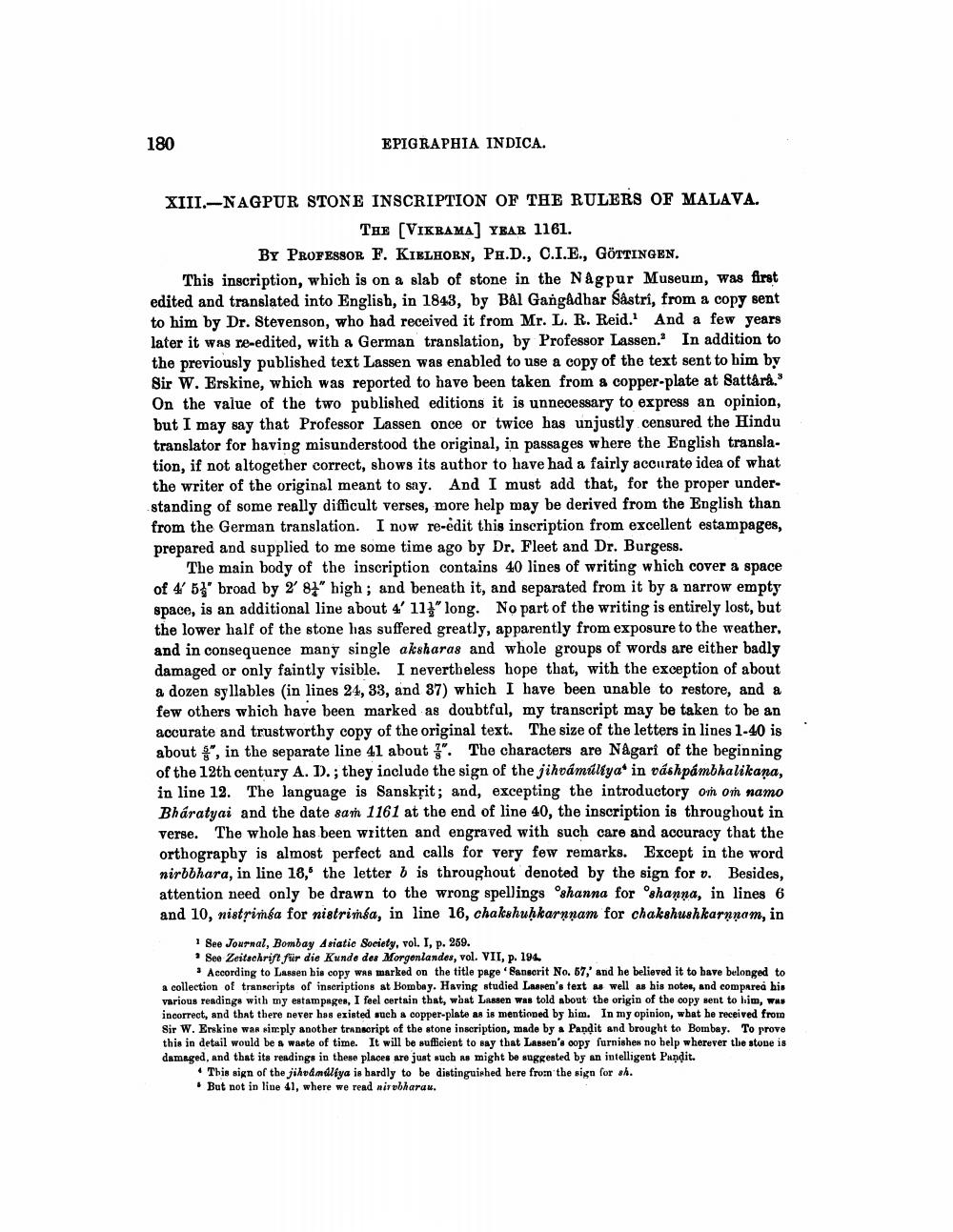________________
180
EPIGRAPHIA INDICA.
XIII.-NAGPUR STONE INSCRIPTION OF THE RULERS OF MALAVA.
THE [VIKRAMA] YEAR 1161.
BY PROFESSOR F. KIELHORN, PH.D., C.I.E., GÖTTINGEN.
This inscription, which is on a slab of stone in the Nagpur Museum, was first edited and translated into English, in 1843, by Bal Gangadhar Sâstri, from a copy sent to him by Dr. Stevenson, who had received it from Mr. L. R. Reid. And a few years later it was re-edited, with a German translation, by Professor Lassen. In addition to the previously published text Lassen was enabled to use a copy of the text sent to him by Sir W. Erskine, which was reported to have been taken from a copper-plate at Sattârâ." On the value of the two published editions it is unnecessary to express an opinion, but I may say that Professor Lassen once or twice has unjustly censured the Hindu translator for having misunderstood the original, in passages where the English translation, if not altogether correct, shows its author to have had a fairly accurate idea of what the writer of the original meant to say. And I must add that, for the proper understanding of some really difficult verses, more help may be derived from the English than from the German translation. I now re-edit this inscription from excellent estampages, prepared and supplied to me some time ago by Dr. Fleet and Dr. Burgess.
The main body of the inscription contains 40 lines of writing which cover a space of 4′ 51′′ broad by 2' 8" high; and beneath it, and separated from it by a narrow empty space, is an additional line about 4' 11" long. No part of the writing is entirely lost, but the lower half of the stone has suffered greatly, apparently from exposure to the weather, and in consequence many single aksharas and whole groups of words are either badly damaged or only faintly visible. I nevertheless hope that, with the exception of about a dozen syllables (in lines 24, 33, and 37) which I have been unable to restore, and a few others which have been marked as doubtful, my transcript may be taken to be an accurate and trustworthy copy of the original text. The size of the letters in lines 1-40 is about", in the separate line 41 about ". The characters are Nagari of the beginning of the 12th century A. D.; they include the sign of the jihvámúliya in váshpámbhalikana, in line 12. The language is Sanskrit; and, excepting the introductory om om namo Bharatyai and the date sam 1161 at the end of line 40, the inscription is throughout in verse. The whole has been written and engraved with such care and accuracy that the orthography is almost perfect and calls for very few remarks. Except in the word nirbbhara, in line 18, the letter b is throughout denoted by the sign for v. Besides, attention need only be drawn to the wrong spellings shanna for shanna, in lines 6 and 10, nistrimea for nistrimsa, in line 16, chakshuḥkarnṇam for chakshushkarnṇam, in
1 See Journal, Bombay Asiatic Society, vol. I, p. 259.
See Zeitschrift für die Kunde des Morgenlandes, vol. VII, p. 194.
According to Lassen his copy was marked on the title page 'Sanscrit No. 57,' and he believed it to have belonged to a collection of transcripts of inscriptions at Bombay. Having studied Lassen's text as well as his notes, and compared his various readings with my estampages, I feel certain that, what Lassen was told about the origin of the copy sent to him, was incorrect, and that there never has existed such a copper-plate as is mentioned by him. In my opinion, what he received from Sir W. Erskine was simply another transcript of the stone inscription, made by a Pandit and brought to Bombay. To prove this in detail would be a waste of time. It will be sufficient to say that Lassen's copy furnishes no help wherever the stone is damaged, and that its readings in these places are just such as might be suggested by an intelligent Pandit.
This sign of the jihvâmúliya is hardly to be distinguished here from the sign for sh. But not in line 41, where we read nirbharau.




